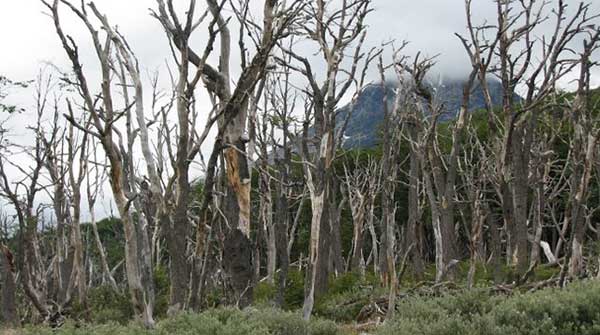Dead trees are important in our landscape, with many species relying on them for survival
 We see them every day, and, essentially, most people just ignore them. Hundreds of thousands of them were created a few years ago when the Emerald Ash Borer invaded North America. Communities rallied to cut them down and place restrictions on the movement of firewood between municipalities.
We see them every day, and, essentially, most people just ignore them. Hundreds of thousands of them were created a few years ago when the Emerald Ash Borer invaded North America. Communities rallied to cut them down and place restrictions on the movement of firewood between municipalities.
We’re talking about trees here.
Well, with the ash trees killed by the borer, it made sense – cut them down and stop the spread! But, for other trees, is it a good idea to cut them down, or can we leave them standing (or fallen)? Once we set aside property damage risks and human health concerns, we should try to leave them in place as much as we can.
Realizing that many people have small lots, it is a bit unfair to expect everyone to leave a fallen trunk in the yard or a standing dead tree on the fence line.
 |
| Related Stories |
| How did animals get their names?
|
| Trees near farmland pay environmental dividends
|
| The elegant and essential cones of coniferous trees
|
Or is it?
As urbanization encroaches more and more, we find that wildlife benefits less and less. What might appear to be an unsightly hunk of wood to us is a home and food for myriad animals. Let’s explore this a bit.
A fallen tree serves many purposes. It can be food and a foundation for other organisms, such as small plants and mushrooms, as the wood decays. Insects will probe its rotting structure as they eat the wood and other animals and plants attracted to the bounty. Some animals use the log (as it hollows out over time) for shelter or nesting. The Turkey Vulture is one bird that will nest inside a suitable log.
As the log continues to rot, it will fertilize the soil around it and more plants and animals will benefit. Piles of fallen branches serve a similar function but have the added benefit of providing shelter to migrating birds within their complex intertwined stems.
The carcass of a standing tree provides even more benefits to wildlife. The snag (the name for dead trees that are left upright to decompose naturally) is an important lookout point for birds big and small. They can perch on the tallest point and watch for predators, competitors or food. Hawks will perch here to watch for prey below and, when seen, dive toward the ground in pursuit. Flycatchers will likewise dash out to catch a passing bug. Smaller birds will search the cracks, crevices, and loose bark looking for sedentary prey, while many birds will sing for a mate and territory from its outer branches.
The greatest benefit seems to be that the structure provides a home to countless insects, many mammals and numerous birds that nest within its trunk or larger branches. Species such as flying squirrels may nest or roost in an abandoned woodpecker hole. Many birds will either excavate their own nest hole or occupy an abandoned one. Woodpeckers, kestrels, wood ducks, goldeneye, chickadees and more will use holes in the tree for nesting. Others species, such as the Brown Creeper or Red-breasted Nuthatch, may nest behind the bark of the dead tree. Formerly, Chimney Swifts nested inside hollow trees as there were few homes and fewer chimneys they could use for roosting and nesting. Bats will also roost behind the bark or even inside the tree trunk.
My personal favourite tree is a 30-foot-tall White Ash that was killed by the borer about three years ago, but it still stands with my neighbour’s indulgence on the boundary between our two properties.
I like it because it is a magnet for birds. They come to sit and wait near the feeder, watch for mates, sing from its highest branches or glean invisible food clinging to its bark. Over the last couple of years I have seen over 72 species of birds sitting in this single tree.
So, when you see a dead tree, don’t overlook it – take a minute and marvel at its importance in our landscape and cherish the many species that rely on it for survival.
Geoff Carpentier is a published author, expedition guide and environmental consultant. Visit Geoff on LinkedIn, Instagram and Facebook.
For interview requests, click here.
The opinions expressed by our columnists and contributors are theirs alone and do not inherently or expressly reflect the views of our publication.
© Troy Media
Troy Media is an editorial content provider to media outlets and its own hosted community news outlets across Canada.

